Toxicity and horizontal transfer of bifenthrin and dimefluthrin against the red imported fire ant, Solenopsis invicta Buren (Hymenoptera: Formicidae), and the efficacy of their dust applications in the field
2023-05-08LlANGMingrongSHUANGYoumingDENGJiefuPENGLiyaZHANGSenquanZHANGChenXUYijuanLUYongyueWANGLei
LlANG Ming-rong, SHUANG You-ming, DENG Jie-fu, PENG Li-ya, ZHANG Sen-quan, ZHANG Chen, XU Yi-juan, LU Yong-yue, WANG Lei#
1 Red Imported Fire Ant Research Center, South China Agricultural University, Guangzhou 510642, P.R.China
2 Shenzhen Agricultural Science and Technology Promotion Center, Shenzhen Administration for Market Regulation, Shenzhen 518057, P.R.China
Abstract The red imported fire ant, Solenopsis invicta Buren, poses a significant threat to biodiversity, agriculture, and public health in its introduced ranges.While chemicals such as toxic baits and dust are the main methods for S.invicta control, toxic baits are slow, requiring approximately one or two weeks, but dust can eliminate the colony of fire ants rapidly in just three to five days.To explore more active ingredients for fire ant control using dusts, the toxicity of bifenthrin and dimefluthrin, the horizontal transfer of bifenthrin and dimefluthrin dust and their efficacy in the field were tested.The results showed that the LD50 (lethal dose) values of bifenthrin and dimefluthrin were 3.40 and 1.57 ng/ant, respectively.The KT50 (median knockdown time) and KT95 (95% knockdown time) values of a 20 μg mL–1 bifenthrin dose were 7.179 and 16.611 min, respectively.The KT50 and KT95 of a 5 μg mL–1 dimefluthrin dose were 1.538 and 2.825 min, respectively.The horizontal transfers of bifenthrin and dimefluthrin among workers were effective.The mortality of recipients (secondary mortality) and secondary recipients (tertiary mortality) were both over 80% at 48 h after 0.25, 0.50 and 1.00% bifenthrin dust treatments.The secondary mortality of recipients was over 99% at 48 h after 0.25, 0.50 and 1.00% dimefluthrin dust treatments, but the tertiary mortality was below 20%.The field trial results showed that both bifenthrin and dimefluthrin exhibited excellent fire ant control effects, and the comprehensive control effects of 1.00% bifenthrin and dimefluthrin dusts at 14 d post-treatment were 95.87 and 85.70%, respectively.
Keywords: red imported fire ant, pyrethroids, secondary transfer, tertiary mortality, contact toxic dust
1.lntroduction
The red imported fire ant,SolenopsisinvictaBuren, is one of the worst invasive species worldwide, and it is now distributed in the United States, Mexico, Australia, China, West Indies, and elsewhere because of increasing international spread, such as through trade and transportation (Vinson 2013; Wanget al.2020a; Zhanget al.2022).In 2021, over 450 counties in 15 provinces of China were infested byS.invicta(Luet al.2019; Wanget al.2020a; MARAPRC 2021).Solenopsisinvictacan cause serious problems for human health, public safety, agriculture, the economy, and ecology in its introduced regions (Vinson 2013; Wanget al.2020a, b).Solenopsisinvictainfestation has negative ecological impacts on a variety of habitats in South China, including disruption of the arthropod community structure and declines in the diversity and abundance of native ant species (Wanget al.2020a).Moreover,S.invictacan replace native ants in mutualistic relationships with Hemiptera that produce honeydew, depleting vital food sources for native ants and their natural predators (Wanget al.2019, 2020a; Xuet al.2022).Circuitry damage and mound buildings in and around electrical poles/sign boards cause material deterioration (Vinson and MacKay 1990; Xuet al.2022).Investigations have shown that approximately onethird of people in fire ant-infested regions in China had been stung in the past, and approximately 10% of them struggled with severe hypersensitivity (Xuet al.2012; Zhao and Xu 2015).Hu (2008) reported thatS.invictacauses 105.90 USD ha–1direct loss and 391.98 USD ha–1indirect loss in the agriculture sector in Fujian Province.
Fire ant control mainly depends on chemicals, including toxic baits and dusts (Klotzet al.1997; Vogtet al.2002).Although they are effective for fire ant management, toxic baits are slower-acting and need approximately 1–2 weeks to kill fire ant colonies (Stringer 1964; Kafleet al.2010).Spraying toxic baits broadly may also cause nontarget effects.Toxic dust can be transferred to fire ant populations by social behaviors, such as grooming and necrophoresis, and reduce fire ant populations in 3–5 days, which may lead to queen death and ultimately eradicate the whole colony (Drees and Frisbie 2002; Sunet al.2016; Verzaet al.2017).Many recent reports indicate that fire ants may perform burying behavior, which might reduce bait efficacy over time (Qinet al.2019; Wenet al.2021).In addition, as toxic dust must be applied onto its target, it can be used for controlling fire ants in sensitive areas such as nature reserves and wilderness areas to avoid nontarget effects, such as being mistakenly eaten by birds and native ants (Buczkowski and Wossler 2019).
Pyrethroids are usually applied for the management of many pests, including fire ants, due to their high toxicity, rapid knockdown activity against pests, and low mammalian toxicity (Matsuo and Mori 2012; Yuanet al.2019).Zhenget al.(2010) demonstrated that the mortality of mounds reached 100% five days after a 4.5% beta-cypermethrin EC mound drench treatment, and no mounds were subsequently relocated near the treated mounds.However, mound drenching to control fire ants in the field requires a large amount of labor and works inefficiently.Tanet al.(2014) reported that lambdacyhalothrin has excellent lethal efficacy on fire ants with a short killing time and effective horizontal activity.Bifenthrin exhibits high horizontal toxicity and high lethal efficiency against fire ants (Wiltzet al.2010; Zhanget al.2022), but its dust formulation has only rarely been reported to eliminate fire ants.Dimefluthrin has not been evaluated for fire ant control thus far.To facilitate fire ant control implementation in the field and to minimize the impact on nontarget organisms, the toxicity of bifenthrin and dimefluthrin, the horizontal transfer of bifenthrin and dimefluthrin dusts and their efficacy in the field were evaluated in this study.
2.Materials and methods
2.1.lnsects and experimental materials
Bifenthr in(concentration≥95%,Guangzhou DeNO Biological Co., Ltd., China), dimefluthrin (concentration≥95%, Guangzhou Qinjian Instrument Co., Ltd., China), activated clay (Henan Hongshu Environmental Protection Material, China), and talc powder (Zhengzhou Hongsheng Talc Powder Products, China) were used in this experiment.
Fire ant colonies were collected from a wasteland at Hai’ou Island, Guangzhou, Guangdong Province (113°30´47´´E, 22°58´9´´N).Fire ant colonies were reared in plastic boxes in which the inner walls were painted with a mixture of talc powder and ethanol to keep the fire ants from escaping (Ninget al.2019).FrozenLocustamigratoriaand 10% w/w sugar water were provided.All colonies were reared under laboratory conditions of 26°C, a 14 h L:10 h D cycle, and a relative humidity of 60%, which was maintained for 2 weeks before the experiments.
2.2.Toxicity of bifenthrin and dimefluthrin
Contact toxicity of bifenthrin and dimefluthrinLarge worker ants (1.20–1.40 mm head width) were used because of the uniformity of their body size.Bifenthrin and dimefluthrin were diluted with acetone, and 1 μL of each concentration solution was dripped on the pronotum of workers following Wang and Chen (2015).Then, the treated workers were placed into a plastic bowl (diameter=10 cm), and 10% w/w sugar water was supplied.The number of dead workers was counted after 24 h.For bifenthrin, concentrations of 12, 6, 3, 1.5, and 0.75 μg mL–1were tested.For dimefluthrin, concentrations of 12, 6, 3, 1.5, 0.75, and 0.325 μg mL–1were tested.Acetone was used as the control.Each concentration had three replicates, and 30 large workers were used for each replicate.The whole experiment was repeated twice using two different colonies.During the experiment, all solutions were placed on ice to prevent the rapid volatilization of the acetone solvent.All bioassays were conducted under laboratory conditions of 26°C, a 14 h L:10 h D cycle, and a relative humidity of 60%.
Knockdown efficiency of bifenthrin and dimefluthrinTo test the knockdown efficiency of bifenthrin and dimefluthrin, large workers were placed into a glass Petri dish (90 mm) coated with Fulon on its edge to keep workers from escaping.Then, either bifenthrin or dimefluthrin solution was sprayed on the fire ant workers using a hand-held misting bottle (two sprays; total volume 0.2 mL) (Wiltzet al.2010).For bifenthrin, doses of 20, 10, and 5 μg mL–1were tested.For dimefluthrin, doses of 5, 1, and 0.5 μg mL–1were tested.Since acetone was used as the solvent to dilute bifenthrin and dimefluthrin, it was used as a control.The number of workers that could not stand by themselves and be trembling were recorded at regular intervals (dimefluthrin: 0.5 μg mL–1for 3 min, 1 μg mL–1for 40 s, and 5 μg mL–1for 20 s; bifenthrin: 5 μg mL–1for 2 min, 10 and 20 μg mL–1for 20 s) until almost all the tested workers had fallen.Each treatment was conducted in five replicates, and 50 large workers were used for each replicate.The whole experiment was repeated twice using two different colonies.All bioassays were conducted under laboratory conditions of 26°C, a 14 h L:10 h D cycle, and a relative humidity of 60%.
2.3.Horizontal transfer of bifenthrin and dimefluthrin
Both the solution and toxic dust formulations of bifenthrin and dimefluthrin were tested in a horizontal transfer experiment to evaluate their horizontal transfer efficiency among the fire ant workers.
For the solutions, bifenthrin and dimefluthrin were diluted with acetone.Solutions of both bifenthrin and dimefluthrin were prepared at 30 and 60 μg mL–1.During the experiment, all solutions were placed on ice to prevent the rapid volatilization of the acetone.The method for testing the horizontal transfer of the bifenthrin and dimefluthrin solutions was adapted from Buczkowski (2019).The horizontal transfer experiment was divided into two parts: the first round and the second round of horizontal transfer.(1) For the first round of horizontal transfer, 1 μL of test solution was dripped onto the pronotum of large workers.Five treated large workers (donors) were placed into a plastic bowl (diameter=10 cm) containing 50 healthy large workers (recipients) from the same colony, and 10% w/w sugar water was supplied to provide nutrition and water for the workers.To distinguish the donors from the recipients, the tarsus segment of the left middle leg of the donors was removed before treatment, which did not affect the activity or behavior of the feeding ants (Buczkowski 2019).The mortality of recipients (secondary mortality) was recorded at 3, 6, 9, 12, 24, 36, and 48 h post-treatment.In the control, workers treated with acetone alone were used as donors.Each concentration was tested in triplicate.The whole experiment was repeated twice with different colonies.(2) For the second round of horizontal transfer, to evaluate whether bifenthrin and dimefluthrin caused tertiary mortality by horizontal transfer, five corpses of the recipients from the first-round trial at 48 h post-treatment were taken as the donors (secondary donors).The five secondary donors were placed in a plastic bowl containing 50 large workers (secondary recipients), and 10% w/w sugar water was supplied.The mortality of the secondary recipients (tertiary mortality) was recorded at 6, 12, 24, 36, 48, 60, and 72 h post-treatment.Five recipients from the control treatment of the first-round experiment were used as secondary donors in the control (acetone) treatment of the second-round experiment.When the number of dead recipients was insufficient, recipients from the control treatment were frozen to death in a –20°C refrigerator and used as secondary donors in the control treatment of the second round of dust transfer.Three replicates were conducted for each treatment.The whole experiment was repeated twice with different colonies.All bioassays were performed under laboratory conditions of 25°C with a 14 h L:10 h D cycle and a relative humidity of 60%.
For toxic dust testing, bifenthrin and dimefluthrin were thoroughly mixed with activated clay and talc powder to obtain the test concentrations of toxic dust.Based on preliminary experiments, dust formulations with 0.25, 0.50, and 1.00% bifenthrin and dimefluthrin were tested.
The method for determining the horizontal transfer of bifenthrin and dimefluthrin dusts was similar to the method for the horizontal transfer of bifenthrin and dimefluthrin solutions.The first round and the second round of horizontal transfer were also tested.For the first round of the experiment, the donor workers were treated with 100 mg of bifenthrin and dimefluthrin dust.Four replicates were conducted for each treatment.The whole experiment was repeated twice with different colonies.
2.4.Control effects of bifenthrin and dimefluthrin on fire ants in the field
The field trial was performed at Shenzhen Forest Park, Guangdong Province (22°49´32´´N, 113°53´5´´E).Fire ants in the park were polygyne colonies.Based on the results of the horizontal transfer experiment, 0.25, 0.50, and 1.00% bifenthrin and dimefluthrin dusts were used to test their efficacy on fire ants.
Since fire ant workers will rush to the surface of the mound to attack intruders when their mound is disturbed, the aboveground part of the fire ant mounds was first destroyed with a small shovel.Then, dust was sprinkled onto the workers walking on the surface of the destroyed mound after 1 min.Since fire ant mound volume is closely related to dry colony biomass and the relationship can be expressed as log(Mound volume)=–3.82+1.06log (Mass of all ants) (Tschinkel 1993), 40 g of dust was used per mound in the treatment when the mound diameter was over 30 cm; otherwise, 30 g of dust was applied.No treatment was used in the control experimental plots.The trial site was divided into four plots.The plot of each experimental area could not be less than 200 m2, and every group of six active mounds was regarded as one plot.The diameter of each treated mound exceeded 10 cm, and the distances between mounds were all at least 4 m.The distance between each plot was not less than 5 m.Each experimental plot was randomly assigned to the treatment or control.Each treatment had four plots, i.e., 24 mounds for all the treatments and control.Before treatment, spinosad bait was used to kill fire ant mounds within 5 m of the experimental plots (Zhuanget al.2008).
The number of foraging workers in each treatment plot was trap-counted 1 day before treatment and at 7 and 14 days after the treatment between 9:00–11:00 a.m.and 3:00–5:00 p.m.The traps were made of a 5-mmthick sliced ham sausage and a 30-mL plastic wide-mouth bottle with an opening at the upper end.Five traps that were approximately 5 m apart were randomly placed in each plot.After 30 min, the traps were collected, and the number of captured fire ant workers in each trap was counted.
The numbers of active workers and active mounds were also evaluated 7 and 14 days post-treatment in the experimental plots.A wooden rod was inserted into the mound, and it was considered active if more than three workers came out from the disturbed mound in 60 s (Zhuanget al.2008; Tianet al.2010).
At 14 days post-treatment, all treated mounds were excavated to evaluate their mound level.The activity level of each mound was graded by the following standards: grade 0, no individuals survived; grade 1, only workers or pupae and larvae survived; grade 2, all castes of the mound survived except the queen; and grade 3, all castes of the mound survived.Since all mounds in the treatment and control plots were active, the activity level of all mounds before treatment was grade 3.When digging the mound, we excavated and rummaged the mound as much as possible to find the queens, then collected these samples in a sealing plastic bag and identified their caste in the laboratory.Moreover, new mounds within a 1.5-m radius of the original mound were also investigated and counted 14 days post-treatment.The mound levels were scored following Vogtet al.(2002) (Table 1).
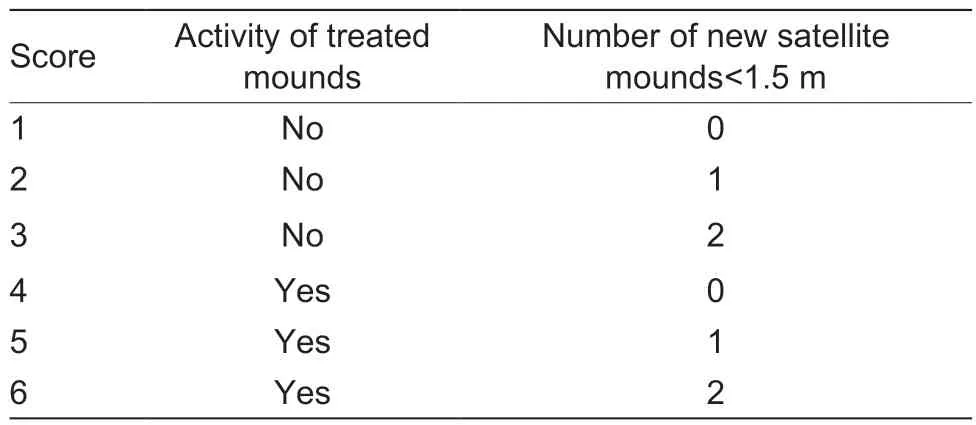
Table 1 Scoring system used to evaluate the effects on mounds treated with bifenthrin and dimefluthrin dust (Vogt et al. 2002)1)
The control effect of dust was evaluated following the protocol (GB/T 17980.149-2009 2009).
The mortality of the fire ant mounds (PN) was calculated as:
where NO, number of active mounds before treatment in the control plot; NTi, number of active mounds posttreatment in the treatment plot; NOi, number of active mounds post-treatment in the control plot; and NTO, number of active mounds before treatment in the treatment plot.
The reduction in fire ant workers (PW) was calculated as:
where WO, average number of captured workers per trap before treatment in the control plot; WTi, average number of captured workers per trap post-treatment in the treatment plot; WOi, average number of captured workers per trap post-treatment in the control plot; and WTO, average number of captured workers per trap before treatment in the treatment plot.
The reduction rate at the colony level (PC) was calculated as:
where CO, average colony level in the control plots before treatment; CTi, average colony level in the treatment plots 14 days post-treatment; COi, average colony level in the control plots post-treatment; and CTO, average colony level in the treatment plots before treatment.
The comprehensive control effect (P) of dust against fire ants was calculated as:
where PN, mortality of fire ant mounds; PW, reduction in fire ant workers; and PC, control effect on fire ant mounds.
2.5.Data analysis
The one-sample Kolmogorov–Smirnov test was used to test for the normal distribution of the data.Levene’s test was used to test the homogeneity of variance.For data with a homogeneous variance, one-way ANOVA and Tukey’s test were used for multiple comparisons.For data meeting normal distribution conditions but not complying to uneven variance, Tamhane’s test was used for multiple comparisons.Non-normally distributed data were analyzed using a nonparametric Kruska–Wallis test to compare medians; and differences significant at the 0.05 significance level were subjected to a Mann–Whitney test for pairwise comparisons.All data were processed in Excel 2013 and SPSS 21.0 Software.The analyses of lab experimental data for two colonies were collectively performed on pooled SPSS 21.0 data.The LD50values of insecticides were obtained by using Probit of SPSS 21.0.
3.Results
3.1.Contact toxicity of bifenthrin and dimefluthrin
The LD50values of bifenthrin and dimefluthrin were 3.40 and 1.57 ng/ant for large workers ofS.invicta, respectively (Table 2).
3.2.Knockdown efficiency of bifenthrin and dimefluthrin
The KT50and KT95values of dimefluthrin and bifenthrin are shown in Table 3.The higher concentrations of these two pesticides tested resulted in shorter knockdown times in fire ants.For bifenthrin, the KT50values of 5, 10, and 20 μg mL–1were 31.423, 9.332, and 7.179 min, respectively, and the KT95values were 204.813, 27.955, and 16.611 min, respectively.For dimefluthrin, the KT50values of 0.5, 1, and 5 μg mL–1were 15.525, 5.231, and 1.538 min, respectively, and the KT95values were 45.441, 12.083, and 2.825 min, respectively.These results indicated that both bifenthrin and dimefluthrin exhibited great knockdown effects on fire ants.

Table 2 Contact toxicity of bifenthrin and dimefluthrin in large fire ant workers

Table 3 Knockdown times of bifenthrin and dimefluthrin in fire ant workers
3.3.Horizontal transfer of bifenthrin and dimefluthrin
Bifenthrin solution exhibited excellent horizontal transfer in fire ants (Fig.1-A).In the first round of horizontal transfer, the secondary mortalities of recipient workers reached 48.33 and 66.33% after 12 h of treatment with 30 and 60 μg mL–1bifenthrin solution, respectively, and 84 and 91% at 24 h, respectively (Kruskal–Wallis test, 12 h:χ2=12.544,df=2,P=0.002; 24 h:χ2=12.441,df=2,P=0.002).The secondary mortalities of recipient workers were more than 90% after 36 h of treatment andreached 97.33 and 100% after 48 h of treatment with 30 and 60 μg mL–1bifenthrin, respectively.In the second round of horizontal transfer, the tertiary mortalities of recipient workers caused by both 30 and 60 μg mL–1bifenthrin were only 14% after 24 h of treatment (Kruskal–Wallis test,χ2=14.001,df=2,P=0.001; Fig.1-C).At 36 h after 30 and 60 μg mL–1bifenthrin treatments, the tertiary mortalities of recipient workers reached 34 and 71%, respectively (Kruskal–Wallis test,χ2=15.760,df=2,P<0.001).At 48 h after 30 and 60 μg mL–1bifenthrin treatments, the tertiary mortalities of recipient workers reached 75.33 and 97.67%, respectively (Kruskal–Wallis test,χ2=15.811,df=2,P<0.001).
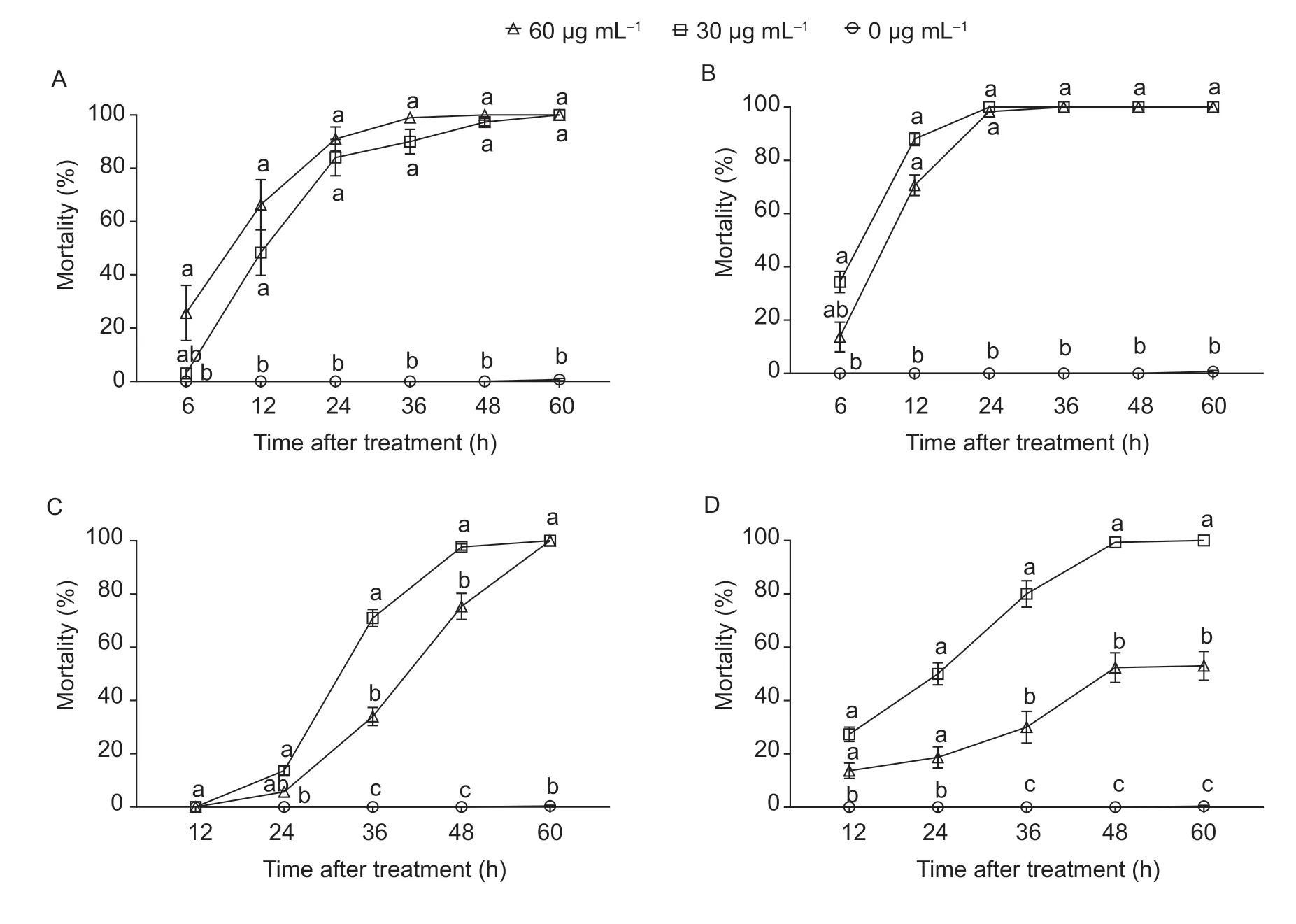
Fig.1 Horizontal toxicity transfer of bifenthrin and dimefluthrin.A and C represent the first-round and second-round toxicity transfer of bifenthrin on workers.B and D represent the first-round and second-round toxicity transfer of dimefluthrin on workers.Data are the mean±standard error (n=8).Identical letters in a figure indicate no significant difference (P>0.05) by the ANOVA test (Tukey test).
Dimefluthrin solution had a fast-lethal effect on recipient workers in the first round of horizontal transfer.Secondary mortalities of recipient workers were 70.67 and 88% caused by 30 and 60 μg mL–1dimefluthrin solution at 12 h post-treatment, respectively, and secondary mortality of recipient workers reached 98.33 and 100% at 24 h, respectively (Kruskal–Wallis test, 12 h:χ2=15.561,df=2,P<0.001; 24 h:χ2=14.856,df=2,P<0.001; Fig.1-B).In the second round of horizontal transfer, the tertiary mortality of recipient workers was only 53% after 60 h of 30 μg mL–1dimefluthrin treatment.Compared to 30 μg mL–1, treatment with 60 μg mL–1dimefluthrin exhibited a higher horizontal transfer effect, and the tertiary mortalities of recipient workers were 80 and 99.33% after 36 and 48 h of treatment, respectively (Kruskal–Wallis test, 36 h:χ2=15.726,df=2,P<0.001; 48 h:χ2=16.088,df=2,P<0.001; Fig.1-D).
Bifenthrin dust exhibited excellent horizontal toxicity transfer in fire ants (Fig.2).In the first round of horizontal toxicity transfer, the secondary mortalities of recipient workers were 14.75, 28.75, and 42.25% after 12 h of 0.25, 0.50, and 1.00% bifenthrin dust treatments, respectively.After 24 h of 0.25, 0.50, and 1.00% bifenthrin dust treatments, the secondary mortalities of recipient workers were 55, 100, and 100%, respectively.At 48 h, the secondary mortality of recipient workers reached 96.50% in the 0.25% concentration treatment, which was significantly higher than that in the control (F3,28=2 732.597,P<0.0001; Fig.2-A).In the second round of toxicity horizontal transfer, the tertiary mortalities of recipient workers caused by 0.25, 0.50 and 1.00% bifenthrin dusts were 46.50, 77, and 84%, respectively, at 24 h post-treatment (F3,28=195.229,P<0.0001; Fig.2-B); while at 48 h post-treatment, the tertiary mortalities of workers were 83, 99.25 and 99.75%, respectively, which was significantly higher than in the control (F3,28=331.223,P<0.0001; Fig.2-B).
In the first round of horizontal toxicity transfer of dimefluthrin dust, the secondary mortalities of recipient workers were 20.75, 26, and 30.25% at 12 h posttreatment with 0.25, 0.50 and 1.00% dimefluthrin dust, respectively.The secondary mortalities of recipient workers caused by 0.25, 0.50, and 1.00% dimefluthrin dusts were 70.50, 75.50, and 80.50% at 24 h posttreatment, respectively.The secondary mortalities of recipient workers were each over 99% for 0.25, 0.50, and 1.00% dimefluthrin dust at 48 h post-treatment, which were significantly higher than in the control (F3,28=3 493.221,P<0.0001; Fig.2-C).In the second round of toxicity horizontal transfer, the tertiary mortalities of recipient workers were 13, 15.5, and 19.25% for 0.25, 0.50, and 1.00% dimefluthrin dusts at 48 h post-treatment, respectively, and there were no significant differences in the tertiary mortalities among the 0.25, 0.50, and 1.00% dimefluthrin dust treatments (F3,28=2.127,P=0.119; Fig.2-D).After 72 h of treatment, the tertiary mortalities of the recipient workers were merely 23, 23.25, and 32.75% for 0.25, 0.50, and 1.00% dimefluthrin dusts, respectively.In the control treatment, the tertiary mortality of recipient workers was only 2.75% after 72 h of treatment, which was not significantly different from the other treatments (F3,28=2.380,P=0.091; Fig.2-D).
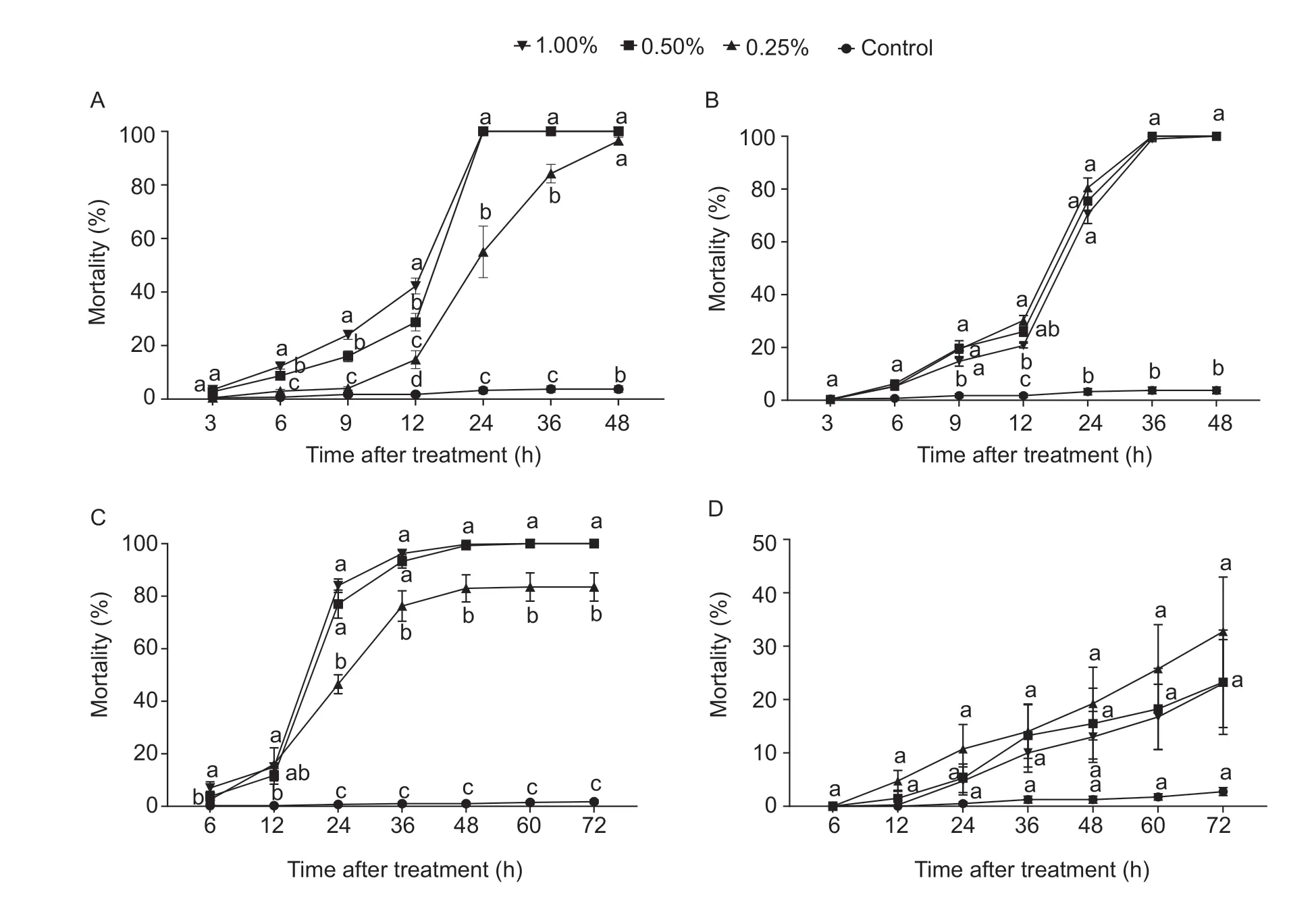
Fig.2 Horizontal toxicity transfer of bifenthrin and dimefluthrin dusts.A and C represent the first- and second-round toxicity transfer of bifenthrin dust on workers.B and D represent the first- and second-round toxicity transfer of dimefluthrin dust on workers.Data are the mean±standard error (n=8).Identical letters in a figure indicate no significant difference (P>0.05) by the ANOVA test (Tukey test).
3.4.Field trial
The effects of 0.25, 0.50, and 1.00% bifenthrin and dimefluthrin dusts against fire ants are shown in Table 4.The mortality of fire ant mounds was 95.83, 87.50, and 75.00% under the 0.25, 0.50, and 1.00% bifenthrin dust treatments, respectively.
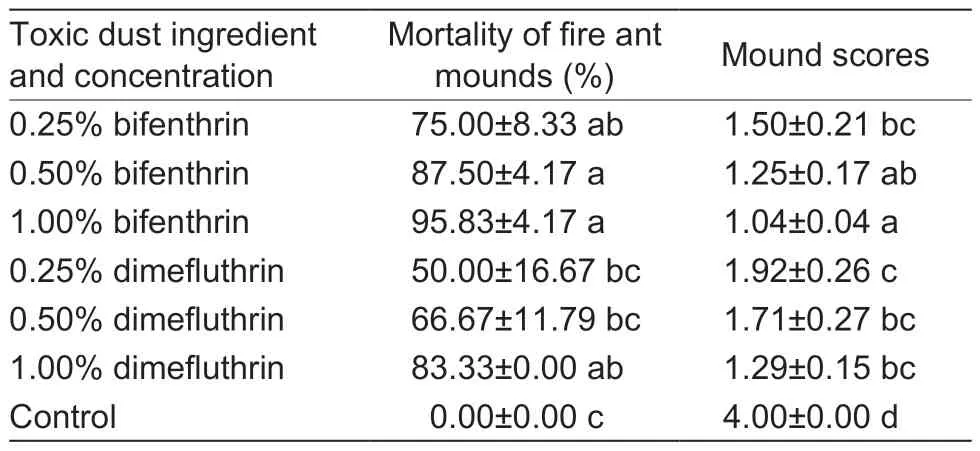
Table 4 Mortality of fire ant mounds and mean mound scores 14 days post-treatment with bifenthrin and dimefluthrin dusts
After 14 days of treatment, the mortality of fire ant mounds reached 95.83% in the 1.00% bifenthrin dust treatment plots, followed by 87.50% mound mortality in the 0.50% bifenthrin dust treatment.The mortalities of mounds treated with 0.50 and 1.00% bifenthrin dusts were significantly higher than that of the 0.25% dimefluthrin dust treatment at 14 days (Mann–Whitney test, for 0.50% bifenthrin dust,W=10.00,Z=–2.428,P=0.015; for 1.00% bifenthrin dust,W=10.00,Z=–2.428,P=0.015).At 14 days post-treatment with 0.50 and 1.00% dimefluthrin dusts, the mortalities of mounds were 66.67 and 83.33%, respectively.
The lower the mound score in the treatment plot, the better the control effect for the fire ant mounds.The mound score of the 1.00% bifenthrin dust was 1.04, which means that no new mounds were relocated to sites around the treated mounds.This mound score was significantly lower those that of the 0.25% bifenthrin and dimefluthrin dust treatments (Mann–Whitney test, for 0.25% bifenthrin dust,W=10.50,Z=–2.247,P=0.025; for 0.25% dimefluthrin dust,W=10.00,Z=–2.381,P=0.017).The mound scores of the 0.25 and 0.50% bifenthrin, and the 1.00% dimefluthrin dust treatment plots were 1.50, 1.25, and 1.29, respectively.There was no significant difference among these treatments (Mann–Whitney test,W=14.00,Z=–1.214,P=0.255;W=14.00,Z=–1.191,P=0.234;W=16.00,Z=–0.615,P=0.538).
The reduction rate of forging workers in plots was 84.40% seven days after 1.00% bifenthrin dust treatment, which was significantly higher than those of the 0.25% dimefluthrin dust and the control (Table 5; Mann–Whitney test, for 0.25% dimefluthrin dust,W=10.00,Z=–2.309,P=0.021; for control,W=10.00,Z=–2.309,P=0.021).
After 14 days of 1.00% bifenthrin dust treatment, the reduction rate of foraging workers in the plots was 96.02%, which was significantly higher than those of the 0.25% bifenthrin, 0.25 and 0.50% dimefluthrin dusts and the control (Tukey test,F6,21=19.842,P<0.001).At 14 days post-treatment with 1.00% dimefluthrin dust and 0.50% bifenthrin dust, the reduction rates of forging workers were 77.51 and 68.29%, respectively, and there was no significant difference between them.In the 0.25% dimefluthrin dust treatment, the reduction rate of forging workers was only 35.87% at 14 days post-treatment.
The control effects of the tested dusts on the fire ant colony are shown in Table 6.The 1.00% bifenthrin dust had the best control efficiency on fire ant colonies, up to 95.83%, followed by 0.50% bifenthrin at 87.50%.The colony reductions of 1.00% dimefluthrin and 0.25% bifenthrin reached 83.33 and 75%, respectively.The effects of 1.00% bifenthrin and dimefluthrin dusts were significantly higher than that of 0.25% dimefluthrin dust (Mann–Whitney test, for 1.00% bifenthrin dust,W=10.00,Z=–2.428,P=0.015; for 1.00% dimefluthrin dust,W=10.00,Z=–2.530,P=0.011).

Table 5 Reduction rates of fire ant workers 7 and 14 days post-treatment with bifenthrin and dimefluthrin dusts
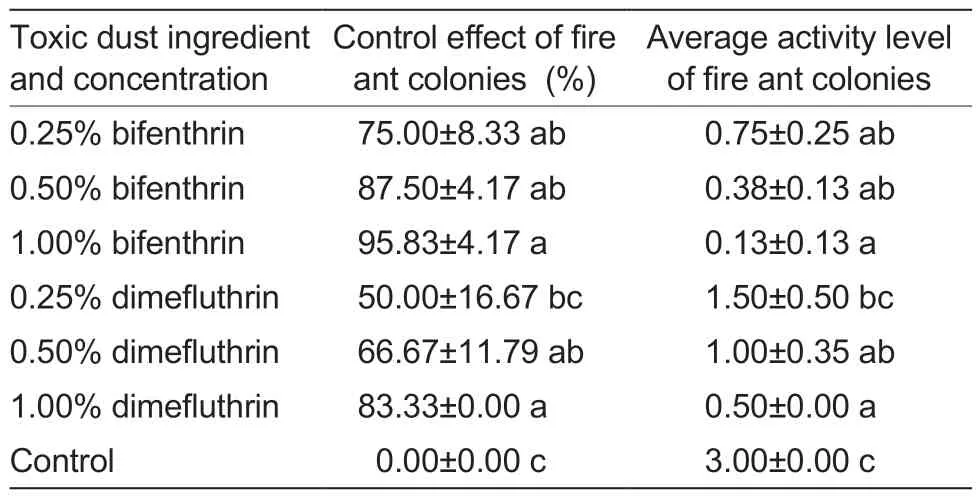
Table 6 Control effects of fire ant colonies 14 days posttreatment with bifenthrin and dimefluthrin dusts
The fire ant colony levels decreased to 0.38 and 0.13 at 14 days after the colonies were treated with 0.50 and 1.00% bifenthrin dusts, respectively.The colony levels after treatment with 0.50 and 1.00% bifenthrin dusts were significantly lower than that of the control, which was 3.0 (Mann–Whitney test; for 0.50% bifenthrin dust,W=10.00,Z=–2.530,P=0.011; for 1.00% bifenthrin dust,W=10.00,Z=–2.530,P=0.011).
The fire ant colony levels decreased to 0.50 and 0.75 at 14 days after the colonies were treated with 1.00% dimefluthrin and 0.25% bifenthrin dust, respectively.There was no significant difference between them (Mann–Whitney test,W=16.00,Z=–1.00,P=0.317).
As shown in Fig.3, the comprehensive control effect of 1.00% bifenthrin dust was the highest (95.87%) at 14 days post-treatment, and it was significantly higher than either the 0.25% bifenthrin or 1.00% dimefluthrin dust treatments (Mann–Whitney test; for 0.25% bifenthrin dust,W=10.00,Z=–2.309,P=0.021; for 1.00% dimefluthrin dust,W=10.00,Z=–2.309,P=0.021).Following treatment with 0.50% bifenthrin and 1.00% dimefluthrin dusts, their comprehensive control effects were 83.66 and 82.17%, respectively.There was no significant difference between them (Mann–Whitney test,W=16.00,Z=–0.577,P=0.564).The comprehensive control effects of 0.25% bifenthrin and 0.25 and 0.50% dimefluthrin dusts were 67.18, 51.39, and 64.89%, respectively.
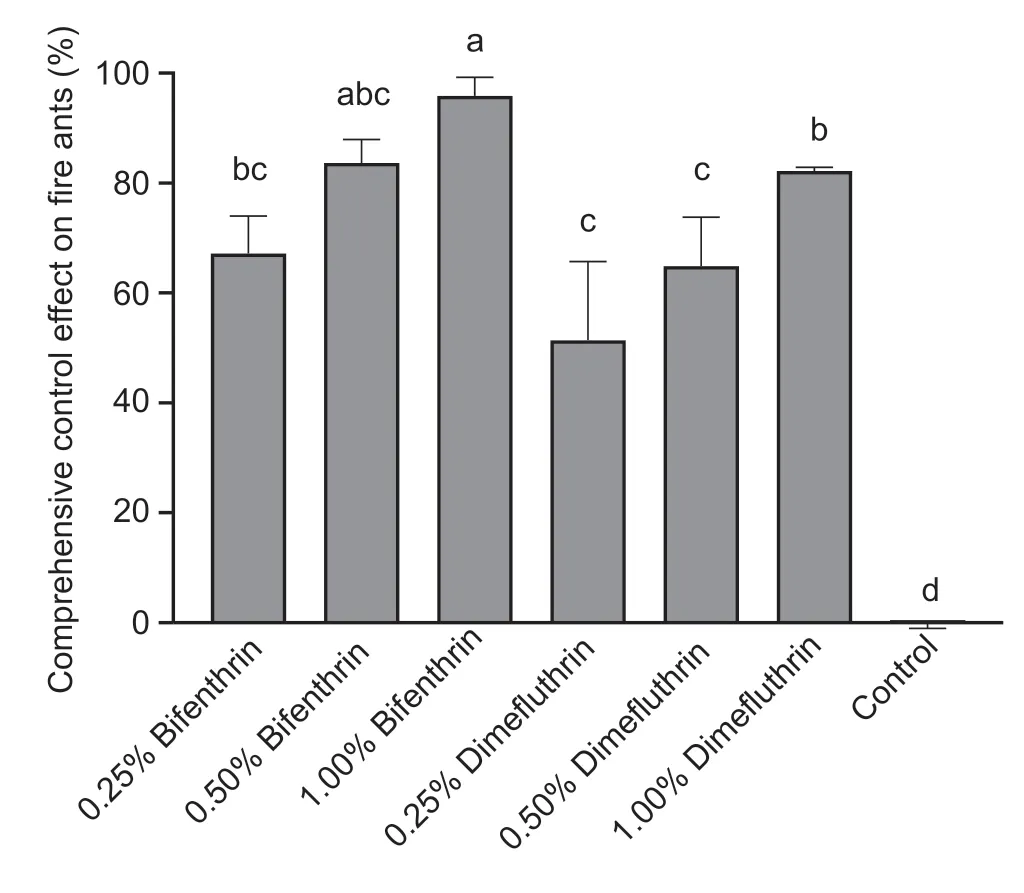
Fig.3 Comprehensive control effect on fire ants 14 days after bifenthrin and dimefluthrin dust treatments.Data are the mean±standard error (n=4).Identical letters indicate no significant difference (P>0.05) by the nonparametric test (Mann–Whitney test).
4.Discussion
Contact insecticides, especially synthetic pyrethroids, are frequently and extensively applied forS.invictacontrol because they can reduce the fire ant population rapidly (Chen and Oi 2020; Zhanget al.2022).Several studies have shown that bifenthrin is a highly effective active ingredient for ant control, including as a barrier or repellent for fire ants (Oi and Williams 1996; Pranschke 2003; Choe and Rust 2008; Wiltzet al.2010).In the present study, bifenthrin dust and dimefluthrin dust were produced, and their control effects were excellent following fire ant mound treatment.The treatments using 30 g of 1.00 and 0.50% bifenthrin dust and 1.00% dimefluthrin dust not only caused over 80% of treated mounds to die without relocation but also reduced the number of foraging ants by over 75% in the treatment plots.
Toxic dust not only acts quickly but also allows more opportunities for horizontal movement of the active ingredient.In contrast to bait ingredients that must act more slowly, chemicals with equivalent delayed toxicity and bioavailability can be excellent ingredients for toxic dusts (Wiltzet al.2010; Yasudaiet al.2022).In our study, the LD50values of bifenthrin and dimefluthrin for large workers ofS.invictawere 3.40 and 1.50 ng/ant, respectively, suggesting that dimefluthrin is more toxic to fire ants.The results showed that the knockdown times of bifenthrin and dimefluthrin were negatively correlated with their concentrations.The KT50and KT95values of 0.5 μg mL–1dimefluthrin were 15.525 and 45.441 min, respectively.The KT50and KT95values of 0.5 μg mL–1dimefluthrin were 15.525 and 45.441 min, respectively.The KT50and KT95values of 5 μg mL–1bifenthrin were 31.423 and 204.813 min, respectively.These results implied that dimefluthrin and bifenthrin have good potential to serve as excellent toxicants in contact dusts because they have a short delay in toxicity, which may provide enough time to allow for horizontal transfer among the fire ant colonies.
Evaluating the toxicity of chemicals is an important step in the development of innovative pesticides for fire ant management (Buczkowski 2019; Buczkowski and Wossler 2019).This study showed that the secondary and tertiary mortalities caused by 60 μg mL–1bifenthrin and dimefluthrin solutions were similar; specifically, the secondary mortality and tertiary mortality were 100 and 97.67% at 48 h after 60 μg mL–1bifenthrin solution treatment, and 100 and 99.33% after 60 μg mL–1dimefluthrin solution treatment.Wiltzet al.(2010) showed that 30 donors sprayed with 0.2 mL of 0.06% bifenthrin and mixed with 300 receipts caused 61.4% secondary mortality at 72 h post-treatment at 20°C.The differences in treatment methods may cause the different secondary mortalities between this method and that of Wiltzet al.(2010).In the toxicant solution horizontal transfer experiment, a single donor ant that had an average of 0.06 μg of either bifenthrin or dimefluthrin was capable of transferring a lethal dose of that compound to approximately 100 workers.Therefore, the amount of either bifenthrin or dimefluthrin required to kill a single fire ant may actually be approximately 0.6 μg.
However, the secondary and tertiary mortalities caused by bifenthrin and dimefluthrin dusts were quite different.Although both 0.50% bifenthrin and dimefluthrin dusts caused 99% secondary mortality 48 h post-treatment, the 0.50% bifenthrin dust caused 99% tertiary mortality 48 h post-treatment, while the 0.50% dimefluthrin dust caused only 15.5% secondary mortality.This result suggests that a donor ant treated with 0.50% dimefluthrin dust is able to transfer a lethal dose to at least 99 ants, but treated with 0.50% dimefluthrin dust is only able to transfer a lethal dose to 15.5 ants.
The reason for this difference may be that the dust carrier in this experiment decreased the residual of dimefluthrin or the lethal dose on the recipients.Further study should be carried out to test this hypothesis.
In the field trial, dusts of either bifenthrin or dimefluthrin increased the mortality of mounds and decreased the number of foragers in the treatment plots.Over 85% of treated mounds died after either 1.00% bifenthrin dust, 0.50% bifenthrin dust, or 1.00% dimefluthrin treatment.Moreover, the number of foragers also deceased by over 68% after either 1.00% bifenthrin dust, 0.50% bifenthrin dust, or 1.00% dimefluthrin treatment.The comprehensive control effect of 1.00% bifenthrin dust was the greatest, at 95.87% after 14 days of treatment.Following treatments with 0.50% bifenthrin and 1.00% dimefluthrin dusts, the comprehensive control effects were 83.66 and 82.17%, respectively.These dusts achieved satisfactory control in the experimental plots with relatively fast operation and effectiveness.Food is transferred between individual antsviatrophallaxis, particularly solid food, which requires larvae to digest and regurgitate it to nurse workers, who disperse the digested (liquidized) food to other cohorts (Cassill and Tschinkel 1999; Yasudaiet al.2022).Toxic dusts could affect larvae through trophallaxis because the larvae may be more sensitive to toxic dust than workers.Larvae can change the food requirements of workers.Because of variations in worker foraging behavior, the larvae may influence the dust toxicity.In addition, the larvae are abundant in the mound.When the toxic dust is applied in the field, it may decelerate the elimination of the workers and the whole colony.
The market prices for 98% bifenthrin, 95% dimefluthrin, and carrier dust are approximately 20, 14, and 7.7 CNY kg–1, respectively, while the prices for 1.00% bifenthrin dust, 0.50% bifenthrin dust, and 1.00% dimefluthrin dust are only 0.32, 0.16, and 0.32 CNY per mound, respectively.In China, the price of the commonly used and high-efficiency cypermethrin dust for fire ant control is approximately 3 CNY per mound.Thus, the 1.00% bifenthrin dust, 0.50% bifenthrin dust, and 1.00% dimefluthrin dust have great price competitiveness.
In this study, toxic dusts were evaluated for their effectiveness in controlling fire ants based on the principles of horizontal transfer.Bifenthrin and dimefluthrin showed excellent control effects in both laboratory and field tests.Further large-scale field control studies of fire ants and extension demonstrations will be conducted to demonstrate their sustainable effectiveness.Moreover, further studies will focus on optimizing the transfer approach of toxic dusts.For instance, a mechanical dust delivery system can be used to improve the efficiency of toxic dust, with reductions in the dose of toxic dust and handling time per mound.
5.Conclusion
This study showed that toxic dust containing either bifenthrin or dimefluthrin exhibited excellent control effects on fire ants 2 weeks after treatment.The results of this study suggested that toxic dusts containing either bifenthrin or dimefluthrin can be applied for quickly eliminating fire ant colonies in the field.
Acknowledgements
This study is supported by the Special Project for Sustainable Development Science and Technology of Shenzhen, China (2021N007), and the Special Project for Red Imported Fire Ant Management, Shenzhen Agricultural Science and Technology Promotion Center, China (20220900044zbzjbc).
Declaration of competing interest
The authors declare that they have no conflict of interest.
杂志排行
Journal of Integrative Agriculture的其它文章
- Review on the fully mulched ridge–furrow system for sustainable maize production on the semi-arid Loess Plateau
- Development and characterization of a novel common wheat–Mexico Rye T1DL·1RS translocation line with stripe rust and powdery mildew resistance
- Revealing the process of storage protein rebalancing in high quality protein maize by proteomic and transcriptomic
- Association mapping of lignin response to Verticillium wilt through an eight-way MAGlC population in Upland cotton
- Dry matter production and panicle characteristics of high yield and good taste indica hybrid rice varieties
- Late sowing enhances lodging resistance of wheat plants by improving the biosynthesis and accumulation of lignin and cellulose
